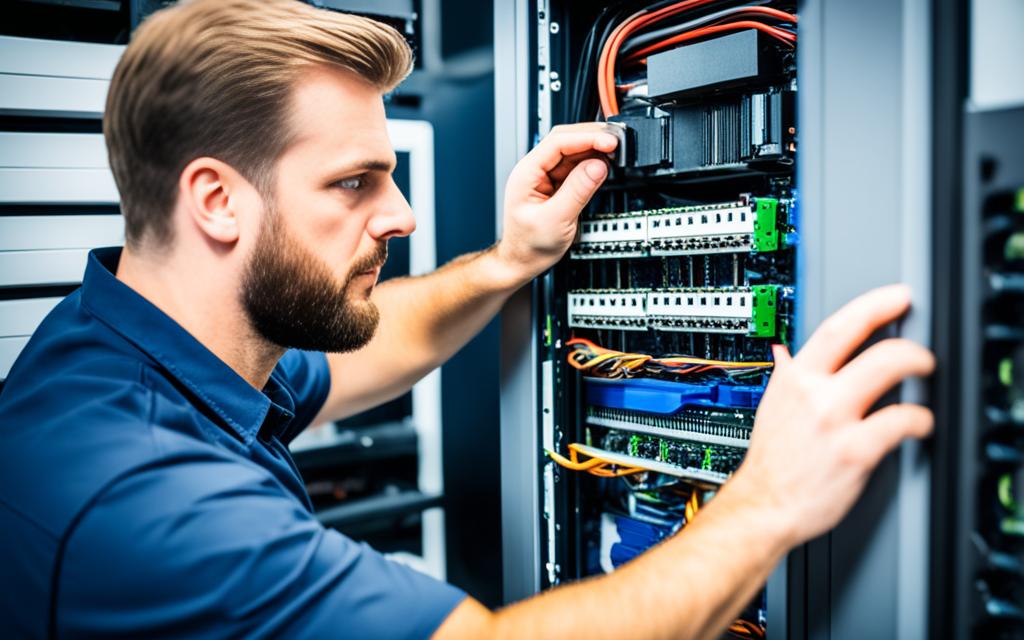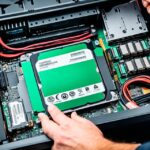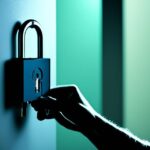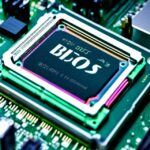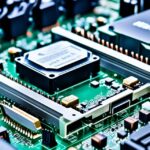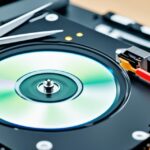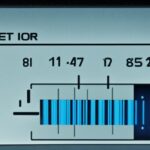Table of Contents
When a hard drive isn’t recognised by the BIOS, it can be very annoying. It stops you from getting to your data and affects your computer’s use. Fixing this is vital, especially if your computer is key to your work. The problem can come from different areas, so you need to look at it closely. Learning about BIOS and how it spots hardware helps in finding the right fix. Fixing this issue means your data is safe and your computer works well again.
Key Takeaways
- Understanding BIOS is crucial for effective troubleshooting.
- Common issues include faulty connections and disabled settings.
- In-depth diagnostics can identify potential hardware failures.
- Modern PCs often require specific cable configurations for optimal performance.
- Additional troubleshooting may involve testing components with other systems.
For help with these problems, check out useful resources. They can guide you through fixing things quickly. A good example is this helpful guide1.
Understanding the BIOS and Its Role in Disk Detection
Knowing what BIOS does is key for all computer users. The Basic Input/Output System (BIOS) is crucial when a computer starts. It runs tests and helps the computer talk to its parts, like hard drives. When hard drives show up in BIOS but Windows can’t see them, it shows how important BIOS is in hard drive detection2.
What is BIOS?
BIOS is firmware found on the motherboard. It starts up the computer, opens the operating system, and oversees the flow of data between the system and devices. Even with UEFI becoming more common, BIOS is still vital for setting up and starting hardware.
How BIOS communicates with the Hard Drive
When the computer is turned on, BIOS talks to the hard drive. It asks for ID and if it’s ready to work. If this chat goes wrong, the hard drive might not show up. Problems could be due to bad connections, old drivers, or damaged firmware3.
Overview of HDD Status in BIOS
In the BIOS menu, you can see the HDD status in BIOS. It tells if the drive is detected and healthy. Not seeing the hard drive there could mean hardware troubles or wrong setup. Watching this status helps fix and keep computers running well.
Common Reasons Why HDD is Not Detected
Understanding why a hard disk drive might not show up in BIOS helps make fixing it easier. Many face common HDD detection issues. There are quite a few reasons these problems can be annoying.
Faulty or Unplugged Data or Power Cables
One big cause of BIOS hard drive problems is bad or disconnected data or power cables. Over time, cables can get loose or even break, which leads to connection problems. It’s important to regularly check that all cables are tightly connected and not damaged, as even bent pins can prevent the HDD from being detected.
Disabled Hard Disk in BIOS Settings
If the HDD is turned off in the BIOS settings, the system won’t see it. This can happen when you’re setting up your system or updating it. To fix this why HDD not detected problem, always make sure the HDD is enabled in the BIOS.
Improper Installation of SATA Drivers
Not installing SATA drivers correctly can also cause detection problems. If drivers aren’t set up right, the BIOS might not find the hard drive at all. Making sure you have the latest SATA drivers can prevent these common HDD detection issues.
Faulty Hard Drive
Sometimes, the issue is with the hard drive itself. If it’s not working properly, it may not show up in BIOS. Using tools to check the HDD’s condition is key. Check for physical damage or issues with the sectors that could stop it from being recognized.
To fix BIOS hard drive problems, it helps to follow a step-by-step method. For deeper insights and solutions on dealing with unrecognized hard drives, check out crucial troubleshooting methods.
How to Fix HDD Not Detected in BIOS
It can be really annoying when your HDD doesn’t show up in BIOS. To tackle this, follow a step-by-step approach. This will help find and sort out the reasons why the BIOS can’t see the hard drive. Here, we’ll outline ways to get your hard drive recognised, including how to enable it in BIOS.
Step 1: Checking Cable Connections
First, check all connections between your hard drive and the motherboard. Look for any signs of damage or wear. If cables are damaged, replacing them might fix the problem. Often, the issue is just a loose or damaged cable.
Step 2: Enabling the HDD in BIOS Setup
Enter the BIOS setup when you start your computer. You can do this by pressing a specific key that’s shown on the screen. Once in, look for the hard drive settings. Enable the HDD if it’s not already. This is key for fixing recognition issues.
Step 3: Updating SATA Drivers
Ensure your SATA drivers are current. Outdated drivers can create compatibility problems. Go to the manufacturer’s website to get the latest drivers. Keeping your drivers updated is vital for solving HDD detection issues.
Step 4: Running Diagnostics to Check for Drive Failure
Use tools like AOME: Partition Assistant to check your hard drive’s health. These tests can tell you if the HDD needs fixing or replacing. It’s an important step in troubleshooting.
Use these strategies to tackle HDD detection problems. For more insights, especially on how bootloaders play a role, check out this article. Bootloaders are crucial in the startup process and can affect hard drive detection41.
Advanced Troubleshooting Techniques
Dealing with HDD detection issues often requires advanced methods. Using an HDD SATA port switch is a key step. These techniques help fix problems in making your hard drive recognizable. Here are the main strategies to try:
Using a Different SATA Port
If your hard drive isn’t showing up, try a different SATA port on your motherboard. Sometimes, motherboard makers turn off SATA ports not in use by default5. Moving the connection could fix issues specific to the port and make the drive visible.
Testing with Alternative Power Supply
A faulty power supply might be the issue. Trying a different power source can help pinpoint if poor power is the problem. When you disconnect the data cable and feel vibrations, it means the disk is getting power5. This can show if the hard disk’s power supply is faulty.
Connecting the HDD to Another Computer
Another test is plugging the hard drive into a different computer. This way, you can see if the issue is with the HDD or the computer itself3. If the second computer shows the drive, the problem might be with the first setup. This leads to more precise troubleshooting.
Conclusion
This article has shown us a simple way to find out why hard drives don’t show up in BIOS. It tells us how using a careful process helps people fix their hard drive issues quickly. We looked at steps from checking cables to making sure drives are active in BIOS.
It’s key to follow the steps if your hard drive doesn’t appear in BIOS. Many people face this issue. By setting the BIOS to “AUTO” and updating drivers, the chances of your hard drive being detected increase6. It’s important to know about possible issues like bad cables or not enough power. This knowledge helps in thorough troubleshooting. Users should also know about using trusted data recovery tools if needed7.
In conclusion, being prepared and informed helps in dealing with hard drive problems. Making sure everything is set up properly is crucial. It keeps your valuable data safe and ensures your system runs well8.
FAQ
What should I do if my hard drive is not detected in BIOS?
Start by making sure the data and power cables are properly connected. If the cables look damaged, you might need to get new ones. Then, go into the BIOS setup when your computer starts and check if the hard drive is turned on. It might help to update the SATA drivers to fix the issue.
Why is it essential to troubleshoot HDD detection issues?
Fixing HDD detection problems is important because they affect accessing your data and how the system works. A hard drive that doesn’t work right can cause you to lose data and slow down your work. That’s why it’s crucial to sort out these problems quickly.
How does BIOS play a role in hard drive detection?
The BIOS helps your computer’s parts, like the hard drive and CPU, talk to each other. When your computer turns on, BIOS checks to make sure it can recognise all connected devices. This is why BIOS is key to making sure hardware works like it should.
What are the common symptoms of a hard drive not being detected?
If your hard drive isn’t showing up in BIOS, or if you get messages that the drive can’t be found, there’s a problem. Also, if your computer won’t start, it could mean the hard drive isn’t being detected. These signs can point to different causes that need checking out.
If I try different SATA ports, what should I expect?
Using other SATA ports might show if the problem is with a specific port. If your hard drive works in a new port, the original port might be broken. This suggests you should look more into the faulty port.
How can I check if my hard drive is functioning correctly?
You can run tests with tools built into your computer or use software from other sources. These checks will tell you if your hard drive is in good shape or if there are problems to be fixed.
Source Links
- https://www.seagate.com/support/kb/the-bios-does-not-detect-or-recognize-the-ata-sata-hard-drive-168595en/ – The BIOS does not detect or recognize the ATA / SATA hard drive | Support Seagate US
- https://www.diskpart.com/articles/bios-detect-hard-drive-but-windows-does-not-7201.html – Solved: BIOS Detect Hard Drive but Windows Does Not in Windows 11/10/8/7
- https://www.easeus.com/recoverdata/hard-disk-not-detected.html – How to Fix Hard Disk Not Detected on Windows 10: Methods Explained
- https://www.diskpart.com/articles/hard-drive-not-showing-up-in-bios.html – 4 Fixes for “Hard Drive Not Showing up in BIOS” in Windows 11, 10, 8, 7
- https://botrecuperacaodedados.com/hard-disk-not-detected-in-bios/ – Hard disk not detected in BIOS: see possible causes and how to solve it
- https://www.systools.in/blog/hard-drive-not-showing-up-in-bios/ – Hard Drive Not Showing up in BIOS Windows : Solved Issue
- https://recoverit.wondershare.com/computer-problems/the-hard-disk-is-not-detected.html – How to Troubleshoot A Hard Disk Is Not Detected? [Video Guide]
- https://www.easeus.com/data-recovery-solution/hard-drive-recognized-in-bios-but-not-in-windows.html – Hard Drive Recognized in BIOS But Not in Windows

